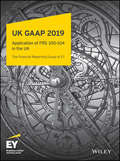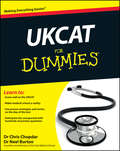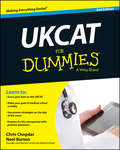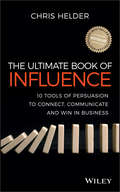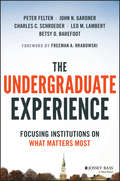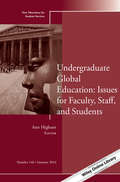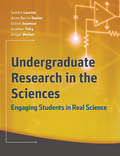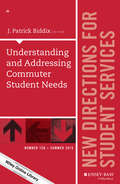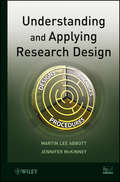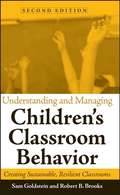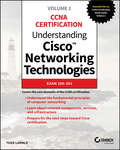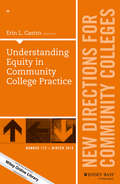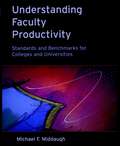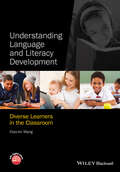- Table View
- List View
UK GAAP 2019: Generally Accepted Accounting Practice under UK and Irish GAAP
by Ernst & Young LLPUK GAAP 2019 provides a comprehensive guide to interpreting and implementing UK accounting standards, particularly: FRS 100: Application of Financial Reporting Requirements FRS 101: Reduced Disclosure Framework — Disclosure exemptions from EU-adopted IFRS for qualifying entities FRS 102: The Financial Reporting Standard applicable in the UK and Republic of Ireland FRS 103: Insurance Contracts FRS 104: Interim Financial Reporting This book is an essential tool for anyone applying, auditing, interpreting, regulating, studying or teaching those accounting standards. Written by the financial reporting professionals from the Financial Reporting Group of EY, this book provides a clear explanation of the UK GAAP accounting requirements which apply in 2019 and will prove invaluable in implementing these requirements. It also addresses the requirements of the UK Companies Act and relevant statutory instruments, as well as practical worked examples. Also available is International GAAP® 2019 — a three volume comprehensive guide to interpreting International Financial Reporting Standards (IFRS), setting IFRS in a relevant business context and providing insight into how complex practical issues should be resolved in the real world of global financial reporting.
UKCAT For Dummies
by Chris Chopdar Neel BurtonThe UK Clinical Aptitude Test (UKCAT) is a standardized test used as an entrance examination for the majority of medical and dental schools in the UK. Its purpose is to test the likely aptitude of a candidate for a clinical career. UKCAT For Dummies provides readers with the review materials they need to score well on the UKCAT and make medical school a reality, featuring: A proven UKCAT preparation program with a five-year history of success Hundreds of a practice questions and explanations Test-taking strategies that work Information and advice on the entire application process from Drs. Chris Chopdar and Neel Burton Go to dummies.com/go/UKCAT to see the latest on UKCAT
UKCAT For Dummies
by Chris Chopdar Neel BurtonThe UK Clinical Aptitude Test (UKCAT) is a standardized test used as an entrance examination for the majority of medical and dental schools in the UK. Its purpose is to test the likely aptitude of a candidate for a clinical career. UKCAT For Dummies provides readers with the review materials they need to score well on the UKCAT and make medical school a reality, featuring: A proven UKCAT preparation program with a five-year history of success Hundreds of a practice questions and explanations Test-taking strategies that work Information and advice on the entire application process from Drs. Chris Chopdar and Neel Burton Go to dummies.com/go/UKCAT to see the latest on UKCAT
UKCAT For Dummies
by Chris Chopdar Neel BurtonFully updated to include the review materials and practice you need for the new Situational Judgment Test The expert advice, instruction, review and practice students need to score high on the UKCAT. If you’re planning on applying to medical or dental school, the new edition of UKAT For Dummies provides a proven formula for success. It’s packed with practice questions, in-depth answers, and strategies and tips for scoring well on each of the test sections, including the Situational Judgment Test and the new question types introduced for the Verbal Reasoning and Abstract Reasoning test sections.
UKCAT For Dummies
by Chris Chopdar Neel BurtonFully updated to include the review materials and practice you need for the new Situational Judgment Test The expert advice, instruction, review and practice students need to score high on the UKCAT. If you’re planning on applying to medical or dental school, the new edition of UKAT For Dummies provides a proven formula for success. It’s packed with practice questions, in-depth answers, and strategies and tips for scoring well on each of the test sections, including the Situational Judgment Test and the new question types introduced for the Verbal Reasoning and Abstract Reasoning test sections.
The Ultimate Book of Influence: 10 Tools of Persuasion to Connect, Communicate, and Win in Business
by Chris HelderMaster the power of influence and persuasion to achieve more in work and life For business leaders and managers, as well as those who work in sales, the power of influence can be a potent advantage. The ability to persuade others based on what you know about them is the first step to convincing someone to buy your product or buy into your business vision. In The Ultimate Book of Influence, author Chris Helder—a master of communication and one of Australia’s most sought after speakers on influence—shares ten essential tools that will enable you to influence others so you win the sale or seal the deal. The tools in this book will show you how to read body language, uncover what’s most important to a client, convince others to take action, understand the four essential types of people at your workplace, and much more. Written by one of Australia’s most successful speakers on the art of influence Includes ten powerful tools that allow you to understand what matters most to a client or colleague and use that knowledge to influence their actions and behaviors Ideal for salespeople, business leaders, corporate executives, and anyone who must regularly convince others to take action Before you can truly influence people, you need to learn how to communicate effectively. The Ultimate Book of Influence teaches you how to choose the right kind of communication technique for any situation, so when you speak, you know people are listening.
The Ultimate Book of Influence: 10 Tools of Persuasion to Connect, Communicate, and Win in Business
by Chris HelderMaster the power of influence and persuasion to achieve more in work and life For business leaders and managers, as well as those who work in sales, the power of influence can be a potent advantage. The ability to persuade others based on what you know about them is the first step to convincing someone to buy your product or buy into your business vision. In The Ultimate Book of Influence, author Chris Helder—a master of communication and one of Australia’s most sought after speakers on influence—shares ten essential tools that will enable you to influence others so you win the sale or seal the deal. The tools in this book will show you how to read body language, uncover what’s most important to a client, convince others to take action, understand the four essential types of people at your workplace, and much more. Written by one of Australia’s most successful speakers on the art of influence Includes ten powerful tools that allow you to understand what matters most to a client or colleague and use that knowledge to influence their actions and behaviors Ideal for salespeople, business leaders, corporate executives, and anyone who must regularly convince others to take action Before you can truly influence people, you need to learn how to communicate effectively. The Ultimate Book of Influence teaches you how to choose the right kind of communication technique for any situation, so when you speak, you know people are listening.
The Undergraduate Experience: Focusing Institutions on What Matters Most
by Peter Felten John N. Gardner Charles C. Schroeder Leo M. Lambert Betsy O. Barefoot Freeman A. HrabowskiA clear, practical framework for getting higher education back on track The Undergraduate Experience is a guide for significantly improving student learning and institutional performance in the rapidly changing world of higher education. Written by recognized experts in undergraduate education, this book encourages college and university leaders to rethink current practices that fragment the student experience, and to focus on creating powerful, integrated undergraduate learning for all students. Drawing from their own deep experience and the latest research, the authors reveal key principles that enable institutional change and enhance student outcomes in any higher education setting. Coverage includes high-impact practices for engagement, the importance of strategic leadership, the necessity of setting and maintaining high expectations, and insight on fostering excellence through systematic planning. Through its core themes and action principles, this book can be a valuable resource for faculty, staff, administrators, and governing boards at all types of postsecondary institutions. The book provides a practical framework for achieving excellence in undergraduate education by focusing on: Learning Relationships Expectations Alignment Improvement Leadership The value of an undergraduate education is under greater scrutiny than ever before, and campus leaders must be able to convey the value of their institutions to students, boards, donors, and legislators. Is a college or university degree worth the increasing cost? Are today's students academically adrift? What's the difference between a degree and an education? Responding to these questions requires focused action by individuals and institutions. The Undergraduate Experience offers practical guidance for creating and sustaining excellence in the face of disruption and change in higher education.
The Undergraduate Experience: Focusing Institutions on What Matters Most
by Peter Felten John N. Gardner Charles C. Schroeder Leo M. Lambert Betsy O. Barefoot Freeman A. HrabowskiA clear, practical framework for getting higher education back on track The Undergraduate Experience is a guide for significantly improving student learning and institutional performance in the rapidly changing world of higher education. Written by recognized experts in undergraduate education, this book encourages college and university leaders to rethink current practices that fragment the student experience, and to focus on creating powerful, integrated undergraduate learning for all students. Drawing from their own deep experience and the latest research, the authors reveal key principles that enable institutional change and enhance student outcomes in any higher education setting. Coverage includes high-impact practices for engagement, the importance of strategic leadership, the necessity of setting and maintaining high expectations, and insight on fostering excellence through systematic planning. Through its core themes and action principles, this book can be a valuable resource for faculty, staff, administrators, and governing boards at all types of postsecondary institutions. The book provides a practical framework for achieving excellence in undergraduate education by focusing on: Learning Relationships Expectations Alignment Improvement Leadership The value of an undergraduate education is under greater scrutiny than ever before, and campus leaders must be able to convey the value of their institutions to students, boards, donors, and legislators. Is a college or university degree worth the increasing cost? Are today's students academically adrift? What's the difference between a degree and an education? Responding to these questions requires focused action by individuals and institutions. The Undergraduate Experience offers practical guidance for creating and sustaining excellence in the face of disruption and change in higher education.
Undergraduate Global Education: New Directions for Student Services, Number 146 (J-B SS Single Issue Student Services)
by Ann HighumFind practical research, strategies, and advice in this issue on the power of global education for 21st-century college learners.This volume assists campus professionals and faculty members as they: Design courses for study abroad Implement programs of various lengths and types Consider their own professional development Evaluate global learning experiences. It also discusses the legal and ethical aspects of providing educational opportunities all over the world, with advice on administrative structures, important principles of risk management, and predeparture orientation for students and program leaders. Covering the history of global learning programs, faculty development, experiential learning, culture shock upon returning home, and program assessment, this volume also includes a wealth of resource information, including websites, checklists, and other publications.
Undergraduate Global Education: New Directions for Student Services, Number 146 (J-B SS Single Issue Student Services)
by Ann HighumFind practical research, strategies, and advice in this issue on the power of global education for 21st-century college learners.This volume assists campus professionals and faculty members as they: Design courses for study abroad Implement programs of various lengths and types Consider their own professional development Evaluate global learning experiences. It also discusses the legal and ethical aspects of providing educational opportunities all over the world, with advice on administrative structures, important principles of risk management, and predeparture orientation for students and program leaders. Covering the history of global learning programs, faculty development, experiential learning, culture shock upon returning home, and program assessment, this volume also includes a wealth of resource information, including websites, checklists, and other publications.
Undergraduate Research in the Sciences: Engaging Students in Real Science
by Sandra Laursen Anne-Barrie Hunter Elaine Seymour Heather Thiry Ginger MeltonUndergraduate research enhances the learning experience of students in science, technology, engineering, and mathematics. Undergraduate Research in the Sciences offers a groundbreaking and practical research-based book on the topic. This comprehensive resource addresses how undergraduate research benefits undergraduate participants, including those populations that are underrepresented in the sciences; compares its benefits with other types of educational activities and experiences; and assesses its long-term value to students and faculty as both a scholarly and educational endeavor. In laying out the processes by which these benefits are achieved, this important book can assist faculty and program directors with practical guidance for design and evaluation of both new and existing undergraduate research programs. Praise for Undergraduate Research in the Sciences "This meticulous, definitive study of the effects of working with a faculty member on research as an undergraduate confirms the overall value of the experience by taking us deep into the minds and actions of participants—both faculty and students. As a result we now have many more compelling reasons to get more students involved with research mentors and ways to optimize the benefits for all parties."—George D. Kuh, Chancellor's Professor and director, Indiana University Center for Postsecondary Research "This timely book offers a unique, comprehensive analysis of undergraduate research in the sciences, based on the voices of college students and faculty mentors who have participated in these voyages of discovery. As our nation struggles to train more scientists, this book will be a valuable resource for designing undergraduate research experiences that can build our country's capacity for discovery and innovation."—Arthur B. Ellis, Vice Chancellor for Research, University of California, San Diego "The text is written in a lucid and engaging style and will be a valuable guide to policymakers, academic administrators, and faculty members who want to find ways to engage undergraduates in the 'real work' of investigation."—Judith A. Ramaley, president, Winona State University "This book is a 'must-read' for anyone who directs undergraduates in research. It presents an impressive and rigorous body of work that brings fresh insights into the field of undergraduate research. The next generation of scientists will benefit greatly from the findings and recommendations!"—Jo Handelsman, Howard Hughes Medical Institute Professor, Yale University
Undergraduate Research in the Sciences: Engaging Students in Real Science
by Sandra Laursen Anne-Barrie Hunter Elaine Seymour Heather Thiry Ginger MeltonUndergraduate research enhances the learning experience of students in science, technology, engineering, and mathematics. Undergraduate Research in the Sciences offers a groundbreaking and practical research-based book on the topic. This comprehensive resource addresses how undergraduate research benefits undergraduate participants, including those populations that are underrepresented in the sciences; compares its benefits with other types of educational activities and experiences; and assesses its long-term value to students and faculty as both a scholarly and educational endeavor. In laying out the processes by which these benefits are achieved, this important book can assist faculty and program directors with practical guidance for design and evaluation of both new and existing undergraduate research programs. Praise for Undergraduate Research in the Sciences "This meticulous, definitive study of the effects of working with a faculty member on research as an undergraduate confirms the overall value of the experience by taking us deep into the minds and actions of participants—both faculty and students. As a result we now have many more compelling reasons to get more students involved with research mentors and ways to optimize the benefits for all parties."—George D. Kuh, Chancellor's Professor and director, Indiana University Center for Postsecondary Research "This timely book offers a unique, comprehensive analysis of undergraduate research in the sciences, based on the voices of college students and faculty mentors who have participated in these voyages of discovery. As our nation struggles to train more scientists, this book will be a valuable resource for designing undergraduate research experiences that can build our country's capacity for discovery and innovation."—Arthur B. Ellis, Vice Chancellor for Research, University of California, San Diego "The text is written in a lucid and engaging style and will be a valuable guide to policymakers, academic administrators, and faculty members who want to find ways to engage undergraduates in the 'real work' of investigation."—Judith A. Ramaley, president, Winona State University "This book is a 'must-read' for anyone who directs undergraduates in research. It presents an impressive and rigorous body of work that brings fresh insights into the field of undergraduate research. The next generation of scientists will benefit greatly from the findings and recommendations!"—Jo Handelsman, Howard Hughes Medical Institute Professor, Yale University
Understanding and Addressing Commuter Student Needs: New Directions for Student Services, Number 150 (J-B SS Single Issue Student Services)
by J. Patrick BiddixDespite representing a majority of the college student population, a surprising lack of research has focused on the unique issues and needs of commuter students. This volume reviews the contemporary research and thinking about commuters. Topics include: • theoretical perspectives and discussions of foremost topics and issues, • specific examples for applying contemporary research with students of color, students with disabilities, and online students, • perspectives for immediate work and strategic planning, and • practical applications, recommendations, and suggestions for supporting commuter students. The volume has four major sections: theory, profiles and issues, support and services, and general applications.This is the 150th volume of this Jossey-Bass higher education quarterly series. An indispensable resource for vice presidents of student affairs, deans of students, student counselors, and other student services professionals, New Directions for Student Services offers guidelines and programs for aiding students in their total development: emotional, social, physical, and intellectual.
Understanding and Addressing Commuter Student Needs: New Directions for Student Services, Number 150 (J-B SS Single Issue Student Services)
by J. Patrick BiddixDespite representing a majority of the college student population, a surprising lack of research has focused on the unique issues and needs of commuter students. This volume reviews the contemporary research and thinking about commuters. Topics include: • theoretical perspectives and discussions of foremost topics and issues, • specific examples for applying contemporary research with students of color, students with disabilities, and online students, • perspectives for immediate work and strategic planning, and • practical applications, recommendations, and suggestions for supporting commuter students. The volume has four major sections: theory, profiles and issues, support and services, and general applications.This is the 150th volume of this Jossey-Bass higher education quarterly series. An indispensable resource for vice presidents of student affairs, deans of students, student counselors, and other student services professionals, New Directions for Student Services offers guidelines and programs for aiding students in their total development: emotional, social, physical, and intellectual.
Understanding and Applying Research Design
by Martin Lee Abbott Jennifer McKinneyA fresh approach to bridging research design with statistical analysis While good social science requires both research design and statistical analysis, most books treat these two areas separately. Understanding and Applying Research Design introduces an accessible approach to integrating design and statistics, focusing on the processes of posing, testing, and interpreting research questions in the social sciences. The authors analyze real-world data using SPSS software, guiding readers on the overall process of science, focusing on premises, procedures, and designs of social scientific research. Three clearly organized sections move seamlessly from theoretical topics to statistical techniques at the heart of research procedures, and finally, to practical application of research design: Premises of Research introduces the research process and the capabilities of SPSS, with coverage of ethics, Empirical Generalization, and Chi Square and Contingency Table Analysis Procedures of Research explores key quantitative methods in research design including measurement, correlation, regression, and causation Designs of Research outlines various design frameworks, with discussion of survey research, aggregate research, and experiments Throughout the book, SPSS software is used to showcase the discussed techniques, and detailed appendices provide guidance on key statistical procedures and tips for data management. Numerous exercises allow readers to test their comprehension of the presented material, and a related website features additional data sets and SPSS code. Understanding and Applying Research Design is an excellent book for social sciences and education courses on research methods at the upper-undergraduate level. The book is also an insightful reference for professionals who would like to learn how to pose, test, and interpret research questions with confidence.
Understanding and Applying Research Design
by Martin Lee Abbott Jennifer McKinneyA fresh approach to bridging research design with statistical analysis While good social science requires both research design and statistical analysis, most books treat these two areas separately. Understanding and Applying Research Design introduces an accessible approach to integrating design and statistics, focusing on the processes of posing, testing, and interpreting research questions in the social sciences. The authors analyze real-world data using SPSS software, guiding readers on the overall process of science, focusing on premises, procedures, and designs of social scientific research. Three clearly organized sections move seamlessly from theoretical topics to statistical techniques at the heart of research procedures, and finally, to practical application of research design: Premises of Research introduces the research process and the capabilities of SPSS, with coverage of ethics, Empirical Generalization, and Chi Square and Contingency Table Analysis Procedures of Research explores key quantitative methods in research design including measurement, correlation, regression, and causation Designs of Research outlines various design frameworks, with discussion of survey research, aggregate research, and experiments Throughout the book, SPSS software is used to showcase the discussed techniques, and detailed appendices provide guidance on key statistical procedures and tips for data management. Numerous exercises allow readers to test their comprehension of the presented material, and a related website features additional data sets and SPSS code. Understanding and Applying Research Design is an excellent book for social sciences and education courses on research methods at the upper-undergraduate level. The book is also an insightful reference for professionals who would like to learn how to pose, test, and interpret research questions with confidence.
Understanding and Managing Children's Classroom Behavior: Creating Sustainable, Resilient Classrooms (Wiley Series on Personality Processes #207)
by Sam Goldstein Robert B. Brooks"This book sets the standard in delivering a comprehensive, state-of-the-art approach for understanding, treating, and preventing classroom behavior difficulties. It should be on the bookshelves of all professionals who work in school settings. I will certainly recommend this text to my colleagues and students." —George J. DuPaul, PhD, Professor of School Psychology, Associate Chair, Education and Human Services, Lehigh University A classic guide to creating a positive classroom environment Covering the most recent and relevant findings regarding behavior management in the classroom, this new edition of Understanding and Managing Children's Classroom Behavior has been completely updated to reflect the current functional approach to assessing, understanding, and positively managing behavior in a classroom setting. With its renewed focus on the concept of temperament and its impact on children's behavior and personality, Understanding and Managing Children's Classroom Behavior emphasizes changing behavior rather than labeling it. Numerous contributions from renowned experts on each topic explore: How to identify strengths and assets and build on them Complete functional behavioral assessments The relationship between thinking, learning, and behavior in the classroom Practical strategies for teachers to improve students' self-regulation How to facilitate social skills Problem-solving approaches to bullies and their victims Medications and their relationship to behavior The classic guide to helping psychologists, counselors, and educators improve their ability to serve all students, Understanding and Managing Children's Classroom Behavior, Second Edition will help educators create citizens connected to each other, to their teachers, to their families, and to their communities.
Understanding Cisco Networking Technologies: Volume 1 Exam 200-301
by Todd LammleCovers the core elements of the CCNA certification: Understand the fundamental principles of computer networking Learn about network components, services, and infrastructure Prepare for the next steps toward Cisco certification Read BEFORE the CCNA Certification Study Guide, Volume 2 — Covers core CiscoTM network technologies Understanding Cisco Networking Technologies, Volume 1, is your first step on the path to preparing for Cisco's EXAM 200-301: Implementing and Administering Cisco Networking Technologies certification and the world of Internetworking. Cisco certification is a perfect way to enter the IT sector or advance your current IT career. Cisco Certified Network Associate (CCNA) is the associate-level certification that validates your ability to implement and administer a wide range of IT networking technologies. This book covers everything you need to know for preparing for both your CCNA studies and the future of your career. You will gain a solid foundational knowledge of networking and develop real-world network management skills. Clear, easy-to-follow chapters cover topics such as the basics of the Open Systems Interconnection (OSI) model, ethernet networking, TCP/IP, the Cisco Internetworking Operating System (IOS) and command-line interface (CLI), router configuration and management, and much more. Throughout the text, practice examples reinforce key information and what you need to know for the CCNA exam. In-depth yet highly readable, Understanding Cisco Networking Technologies is a must-have for anyone thinking of entering the IT profession, preparing for the CCNA certification, or wanting to develop a strong understanding of core Cisco networking technologies. Learn about: Open systems interconnection Ethernet networking and data encapsulation Internet Protocol and IP addressing Subnetting a network Troubleshooting IP issues Managing a Cisco internetwork Configuring network devices IP addressing and static, default and dynamic routing Wide Area Network (WAN) protocols ABOUT THE CISCO CCNA PROGRAM The Cisco Certified Network Associate (CCNA) program prepares candidates for associate-level job roles in IT technologies. The CCNA exam tests a candidate's knowledge and skills related to network fundamentals, network access, IP connectivity, IP services, security fundamentals, and automation and programmability. Visit www.cisco.com/c/en/us/training- events.html for more information.
Understanding Cisco Networking Technologies, Volume 1: Exam 200-301
by Todd LammleLeading Cisco authority Todd Lammle helps you gain insights into the new core Cisco network technologies Understanding Cisco Networking Technologies is an important resource for those preparing for the new Cisco Certified Network Associate (CCNA) certification exam as well as IT professionals looking to understand Cisco’s latest networking products, services, and technologies. Written by bestselling author and internationally recognized Cisco expert Todd Lammle, this in-depth guide provides the fundamental knowledge required to implement and administer a broad range of modern networking and IT infrastructure. Cisco is the worldwide leader in network technologies—80% of the routers on the Internet are Cisco. This authoritative book provides you with a solid foundation in Cisco networking, enabling you to apply your technical knowledge to real-world tasks. Clear and accurate chapters cover topics including routers, switches, controllers and other network components, physical interface and cabling, IPv6 addressing, discovery protocols, wireless infrastructure, security features and encryption protocols, controller-based and software-defined architectures, and more. After reading this essential guide, you will understand: Network fundamentals Network access IP connectivity and IP services Security fundamentals Automation and programmability Understanding Cisco Networking Technologies is a must-read for anyone preparing for the new CCNA certification or looking to gain a primary understanding of key Cisco networking technologies.
Understanding Equity in Community College Practice: New Directions for Community Colleges, Number 172 (J-B CC Single Issue Community Colleges)
by Erin L. CastroWhat do equity-oriented practices look like in different community college contexts? Given the increasing role of the community college in realizing equitable outcomes for students, examples of what practitioners are doing to move forward an equity agenda are urgently needed. The diverse perspectives and issues in these chapters explicitly advance an equity agenda and offer: Conceptual and empirical rationales to support equity-oriented practices, Examples of programming and practice that support the lives and livelihoods of underserved student populations, and Examples of policy, programming, and thinking that emphasize the role of the community college in expanding educational opportunity for underserved students. Driven by a change in thinking and imagination, these examples show how practitioners can—and should—tailor programming in light of larger patterns of inequality. This is the 172nd volume of this Jossey-Bass quarterly report series. Essential to the professional libraries of presidents, vice presidents, deans, and other leaders in today's open-door institutions, New Directions for Community Colleges provides expert guidance in meeting the challenges of their distinctive and expanding educational mission.
Understanding Equity in Community College Practice: New Directions for Community Colleges, Number 172 (J-B CC Single Issue Community Colleges)
by Erin L. CastroWhat do equity-oriented practices look like in different community college contexts? Given the increasing role of the community college in realizing equitable outcomes for students, examples of what practitioners are doing to move forward an equity agenda are urgently needed. The diverse perspectives and issues in these chapters explicitly advance an equity agenda and offer: Conceptual and empirical rationales to support equity-oriented practices, Examples of programming and practice that support the lives and livelihoods of underserved student populations, and Examples of policy, programming, and thinking that emphasize the role of the community college in expanding educational opportunity for underserved students. Driven by a change in thinking and imagination, these examples show how practitioners can—and should—tailor programming in light of larger patterns of inequality. This is the 172nd volume of this Jossey-Bass quarterly report series. Essential to the professional libraries of presidents, vice presidents, deans, and other leaders in today's open-door institutions, New Directions for Community Colleges provides expert guidance in meeting the challenges of their distinctive and expanding educational mission.
Understanding Faculty Productivity: Standards and Benchmarks for Colleges and Universities
by Michael F. Middaugh"An invaluable resource for any college and university striving tomeet the National Cost Commission's call to make what colleges doand what it costs more 'transparent' to the public." --Jacqueline E. King, director, federal policy analysis, AmericanCouncil on Education Defining and measuring faculty productivity are among the mostcentral issues for quality and accountability in higher education.Known for assembling some of the most authoritative research onfaculty productivity--and for analyzing its impact on academic andinstitutional accountability--Michael F. Middaugh presents thiscomprehensive volume to help campus professionals build greateraccountability for students, parents, foundations, governmentalorganizations, and other concerned constituents. Middaugh firstdraws from a research study funded by TIAA-CREF's CooperativeResearch Grant Program and the Fund for Postsecondary Educationwithin the U.S. Department of Education. He then provides a newframework for analyzing faculty efficiency and emphasizes how theresults of faculty work can become the best indicators ofproductivity. He also applies the joint study findings to the taskof developing benchmarks for faculty productivity. Practitionersfrom any type of campus will find a rich array of data, valuablerecommendations, and relevant examples.
Understanding Language and Literacy Development: Diverse Learners in the Classroom
by Xiao-lei WangUnderstanding Language and Literacy Development: Diverse Learners in the Classroom offers effective supporting strategies to address the cultural and linguistic diversity of students in contemporary classrooms. Discusses learners with different linguistic abilities—infancy, early childhood, middle childhood, and adolescence—by suggesting effective ways to reach them based on their strengths and needs Emphasizes language and literacy supporting strategies in a variety of everyday classroom settings Includes activities and questions to motivate readers to think and develop their own perspectives on language and literacy development Considers a variety of different language acquisition experiences, including monolingual, multilingual, and language impairment Discusses different types of literacies, including digital and hypertext Connects language and literacy development to identity and motivation to contextualize learning styles for pre-service teachers Supported by a companion website that includes additional resources such as PowerPoint presentations by chapter and a summary of relevant information from the Common Core K–12 English Language Arts Standards
Understanding Language and Literacy Development: Diverse Learners in the Classroom
by Xiao-lei WangUnderstanding Language and Literacy Development: Diverse Learners in the Classroom offers effective supporting strategies to address the cultural and linguistic diversity of students in contemporary classrooms. Discusses learners with different linguistic abilities—infancy, early childhood, middle childhood, and adolescence—by suggesting effective ways to reach them based on their strengths and needs Emphasizes language and literacy supporting strategies in a variety of everyday classroom settings Includes activities and questions to motivate readers to think and develop their own perspectives on language and literacy development Considers a variety of different language acquisition experiences, including monolingual, multilingual, and language impairment Discusses different types of literacies, including digital and hypertext Connects language and literacy development to identity and motivation to contextualize learning styles for pre-service teachers Supported by a companion website that includes additional resources such as PowerPoint presentations by chapter and a summary of relevant information from the Common Core K–12 English Language Arts Standards
